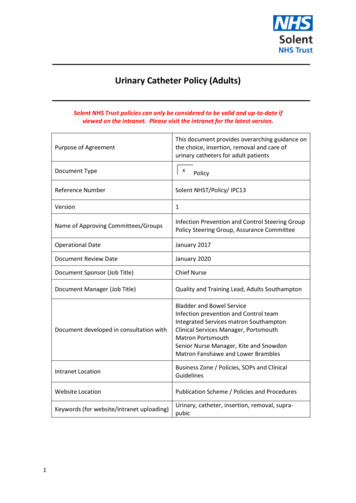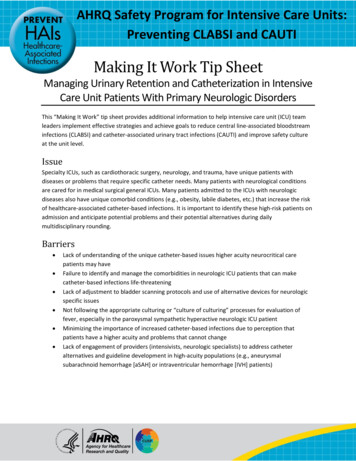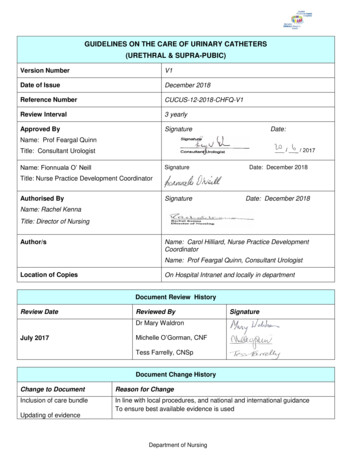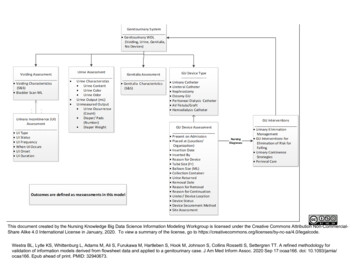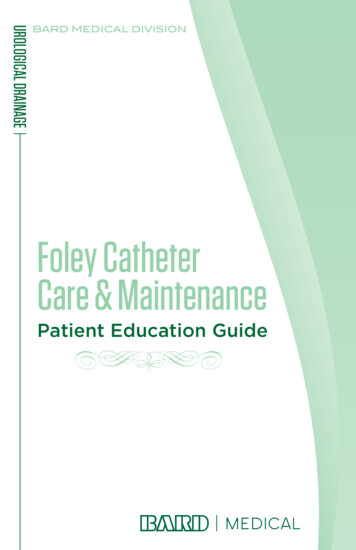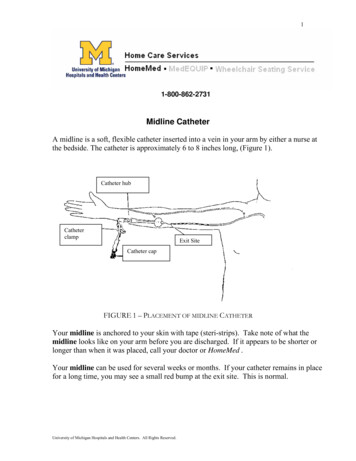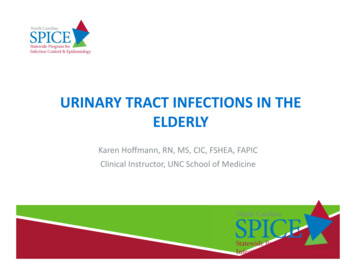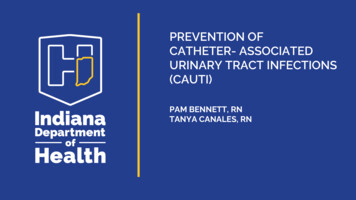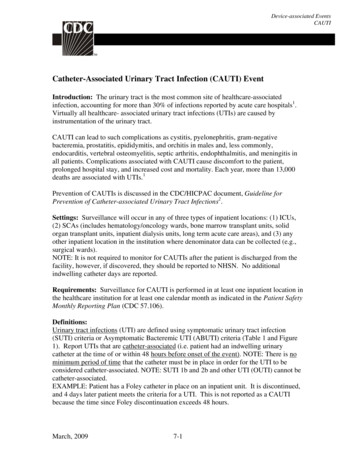
Transcription
Device-associated EventsCAUTICatheter-Associated Urinary Tract Infection (CAUTI) EventIntroduction: The urinary tract is the most common site of healthcare-associatedinfection, accounting for more than 30% of infections reported by acute care hospitals1.Virtually all healthcare- associated urinary tract infections (UTIs) are caused byinstrumentation of the urinary tract.CAUTI can lead to such complications as cystitis, pyelonephritis, gram-negativebacteremia, prostatitis, epididymitis, and orchitis in males and, less commonly,endocarditis, vertebral osteomyelitis, septic arthritis, endophthalmitis, and meningitis inall patients. Complications associated with CAUTI cause discomfort to the patient,prolonged hospital stay, and increased cost and mortality. Each year, more than 13,000deaths are associated with UTIs.1Prevention of CAUTIs is discussed in the CDC/HICPAC document, Guideline forPrevention of Catheter-associated Urinary Tract Infections2.Settings: Surveillance will occur in any of three types of inpatient locations: (1) ICUs,(2) SCAs (includes hematology/oncology wards, bone marrow transplant units, solidorgan transplant units, inpatient dialysis units, long term acute care areas), and (3) anyother inpatient location in the institution where denominator data can be collected (e.g.,surgical wards).NOTE: It is not required to monitor for CAUTIs after the patient is discharged from thefacility, however, if discovered, they should be reported to NHSN. No additionalindwelling catheter days are reported.Requirements: Surveillance for CAUTI is performed in at least one inpatient location inthe healthcare institution for at least one calendar month as indicated in the Patient SafetyMonthly Reporting Plan (CDC 57.106).Definitions:Urinary tract infections (UTI) are defined using symptomatic urinary tract infection(SUTI) criteria or Asymptomatic Bacteremic UTI (ABUTI) criteria (Table 1 and Figure1). Report UTIs that are catheter-associated (i.e. patient had an indwelling urinarycatheter at the time of or within 48 hours before onset of the event). NOTE: There is nominimum period of time that the catheter must be in place in order for the UTI to beconsidered catheter-associated. NOTE: SUTI 1b and 2b and other UTI (OUTI) cannot becatheter-associated.EXAMPLE: Patient has a Foley catheter in place on an inpatient unit. It is discontinued,and 4 days later patient meets the criteria for a UTI. This is not reported as a CAUTIbecause the time since Foley discontinuation exceeds 48 hours.March, 20097-1
Device-associated EventsCAUTILocation of attribution: The location where the patient was assigned on the date of theUTI event, which is further defined as the date when the first clinical evidence appearedor the date the specimen use to meet the criterion was collected, whichever came first.EXAMPLE: Patient has a Foley catheter inserted in the Emergency Department and thenis admitted to the MICU. Within 24 hours of admission to the MICU, patient meetscriteria for UTI. This is reported to the NHSN as a CAUTI for the MICU, because theEmergency Department is not an inpatient location and no denominator data are collectedthere.EXAMPLE: Patient on the urology ward of Hospital A had the Foley catheter removedand is discharged home a few hours later. The ICP from Hospital B calls the next day toreport that this patient has been admitted to Hospital B with a UTI. This CAUTI shouldbe reported to NHSN for Hospital A and attributed to the urology ward.EXCEPTION: If a CAUTI develops within 48 hours of transfer from one inpatientlocation to another in the same facility, the infection is attributed to the transferringlocation. This is called the Transfer Rule and examples are shown below. Patient with a Foley catheter in place in the SICU is transferred to the surgical ward.Thirty six (36) hours later, the patient meets the criteria for UTI. This is reported toNHSN as a CAUTI for the SICU. Patient is transferred to the medical ward from the MSICU after having the Foleycatheter removed. Within 24 hours, patient meets criteria for a UTI. This is reportedto NHSN as a CAUTI for the MSICU. Patient with a Foley catheter in place is transferred from the medical ward to thecoronary care ICU (CCU). After 4 days in the CCU, the patient meets the criteria forUTI. This is reported to NHSN as a CAUTI for the CCU.Indwelling catheter: a drainage tube that is inserted into the urinary bladder through theurethra, is left in place, and is connected to a closed collection system; also called a Foleycatheter; does not include straight in-and-out catheters.Numerator Data: The Urinary Tract Infection (UTI) Form (CDC 57.114) is used tocollect and report each CAUTI that is identified during the month selected forsurveillance. The Instructions for Completion of Urinary Tract Infection Form (Tablesof Instructions, Tables 5 and 2a) includes brief instructions for collection and entry ofeach data element on the form. The UTI form includes patient demographic informationand information on whether or not an indwelling urinary catheter was present. Additionaldata include the specific criteria met for identifying the UTI, whether the patientdeveloped a secondary bloodstream infection, whether the patient died, and theorganisms isolated from cultures and their antimicrobial susceptibilities.Denominator data: Device days and patient days are used for denominators (SeeChapter 16 Key Terms). Indwelling urinary catheter days, which are the number ofpatients with an indwelling urinary catheter device, are collected daily, at the same timeeach day, according to the chosen location using the appropriate form (CDC 57.116,March, 20097-2
Device-associated EventsCAUTI57.117, and 57.118). These daily counts are summed and only the total for the month isentered into NHSN. Indwelling urinary catheter days and patient days are collectedseparately for each of the locations monitored.Data Analyses: The CAUTI rate per 1000 urinary catheter days is calculated by dividingthe number of CAUTIs by the number of catheter days and multiplying the result by1000. The Urinary Catheter Utilization Ratio is calculated by dividing the number ofurinary catheter days by the number of patient days. These calculations will be performedseparately for the different types of ICUs, specialty care areas, and other locations in theinstitution, except for neonatal locations.1Klevens RM, Edward JR, et al. Estimating health care-associated infections and deaths in U.S. hospitals,2002. Public Health Reports 2007;122:160-166.2Wong ES. Guideline for prevention of catheter-associated urinary tract infections. InfectControl 1981;2:126-30.March, 20097-3
Table 1-Urinary Tract Infection CriteriaCriterionSymptomatic Urinary Tract Infection (SUTI)Must meet at least 1 of the following criteria:1aPatient had an indwelling urinary catheter in place at the time of specimen collectionandat least 1 of the following signs or symptoms with no other recognized cause:fever ( 38 C), suprapubic tenderness, or costovertebral angle pain or tendernessanda positive urine culture of 105 colony-forming units (CFU)/ml with no more than 2 species ----------------------------------1b2aPatient had indwelling urinary catheter removed within the 48 hours prior to specimen collectionandat least 1 of the following signs or symptoms with no other recognized cause:fever ( 38 C), urgency, frequency, dysuria, suprapubic tenderness, or costovertebral angle pain ortendernessanda positive urine culture of 105 colony-forming units (CFU)/ml with no more than 2 species ofmicroorganisms.Patient did not have an indwelling urinary catheter in place at the time of specimen collection norwithin 48 hours prior to specimen collectionandhas at least 1 of the following signs or symptoms with no other recognized cause: fever ( 38 C) ina patient that is 65 years of age, urgency, frequency, dysuria, suprapubic tenderness, orcostovertebral angle pain or tendernessanda positive urine culture of 105 CFU/ml with no more than 2 species of microorganisms.Patient had an indwelling urinary catheter in place at the time of specimen collectionandat least 1 of the following signs or symptoms with no other recognized cause:fever ( 38 C), suprapubic tenderness, or costovertebral angle pain or tendernessanda positive urinalysis demonstrated by at least 1 of the following findings:a. positive dipstick for leukocyte esterase and/or nitriteb. pyuria (urine specimen with 10 white blood cells [WBC]/mm3 or 3 WBC/high powerfield of unspun urine)c. microorganisms seen on Gram stain of unspun urineanda positive urine culture of 103 and 105 CFU/ml with no more than 2 species of -------------------------------Patient had indwelling urinary catheter removed within the 48 hours prior to specimen collectionandat least 1 of the following signs or symptoms with no other recognized cause:fever ( 38 C), urgency, frequency, dysuria, suprapubic tenderness, or costovertebral angle pain ortendernessanda positive urinalysis demonstrated by at least 1 of the following findings:a. positive dipstick for leukocyte esterase and/or nitriteb. pyuria (urine specimen with 10 white blood cells [WBC]/mm3 or 3 WBC/high powerMarch, 20097-4
Table 1-Urinary Tract Infection Criteriafield of unspun urine)c. microorganisms seen on Gram stain of unspun urine2b34Criterionanda positive urine culture of 103 and 105 CFU/ml with no more than 2 species of microorganisms.Patient did not have an indwelling urinary catheter in place at the time of specimen collection norwithin 48 hours prior to specimen collectionandhas at least 1 of the following signs or symptoms with no other recognized cause: fever ( 38 C) ina patient that is 65 years of age, urgency, frequency, dysuria, suprapubic tenderness, orcostovertebral angle pain or tendernessanda positive urinalysis demonstrated by at least 1 of the following findings:a. positive dipstick for leukocyte esterase and/or nitriteb. pyuria (urine specimen with 10 WBC/mm3 or 3 WBC/high power field of unspun urine)c. microorganisms seen on Gram stain of unspun urineanda positive urine culture of 103 and 105 CFU/ml with no more than 2 species of microorganisms.Patient 1 year of age with or without an indwelling urinary catheter has at least 1 of the followingsigns or symptoms with no other recognized cause: fever ( 38 C core), hypothermia ( 36 C core),apnea, bradycardia, dysuria, lethargy, or vomitinganda positive urine culture of 105 CFU/ml with no more than 2 species of microorganisms.Patient 1 year of age with or without an indwelling urinary catheter has at least 1 of the followingsigns or symptoms with no other recognized cause: fever ( 38 C core), hypothermia ( 36 C core),apnea, bradycardia, dysuria, lethargy, or vomitinganda positive urinalysis demonstrated by at least one of the following findings:a. positive dipstick for leukocyte esterase and/or nitriteb. pyuria (urine specimen with 10 WBC/mm3 or 3 WBC/high power field of unspun urine)c. microorganisms seen on Gram’s stain of unspun urineanda positive urine culture of between 103 and 105 CFU/ml with no more than two species ofmicroorganisms.Asymptomatic Bacteremic Urinary Tract Infection (ABUTI)Patient with or without an indwelling urinary catheter has no signs or symptoms (i.e., for any agepatient, no fever ( 38 C), urgency, frequency, dysuria, suprapubic tenderness, or costovertebralangle pain or tenderness, or for a patient 1 year of age, no fever ( 38 C core), hypothermia( 36 C core), apnea, bradycardia, dysuria, lethargy, or vomiting)anda positive urine culture of 105 CFU/ml with no more than 2 species of uropathogenmicroorganisms*anda positive blood culture with at least 1 matching uropathogen microorganism to the urine culture.* Uropathogen microorganisms are: Gram-negative bacilli, Staphylococcus spp., yeasts, betahemolytic Streptococcus spp., Enterococcus spp., G. vaginalis, Aerococcus urinae,andCorynebacterium (urease positive).Comments Urinary catheter tips should not be cultured and are not acceptable for the diagnosis of aurinary tract infection. March, 2009Urine cultures must be obtained using appropriate technique, such as clean catch collection orcatheterization. Specimens from indwelling catheters should be aspirated through thedisinfected sampling ports.7-5
Table 1-Urinary Tract Infection CriteriaCriterion1234CommentMarch, 2009 In infants, urine cultures should be obtained by bladder catheterization or suprapubicaspiration; positive urine cultures from bag specimens are unreliable and should be confirmedby specimens aseptically obtained by catheterization or suprapubic aspiration. Urine specimens for culture should be processed as soon as possible, preferably within 1 to 2hours. If urine specimens cannot be processed within 30 minutes of collection, they should berefrigerated, or inoculated into primary isolation medium before transport, or transported in anappropriate urine preservative. Refrigerated specimens should be cultured within 24 hours. Urine specimen labels should indicate whether or not the patient is symptomatic. Report secondary bloodstream infection “Yes” for all cases of Asymptomatic BacteremicUrinary Tract Infection (ABUTI). Report Corynebacterium (urease positive) as either Corynebacterium species unspecified(COS) or, as C. urealyticum (CORUR) if so speciated.Other Urinary Tract Infection (OUTI) (kidney, ureter, bladder, urethra, or tissuesurrounding the retroperineal or perinephric space)Other infections of the urinary tract must meet at least 1 of the following criteria:Patient has microorganisms isolated from culture of fluid (other than urine) or tissue from affectedsite.Patient has an abscess or other evidence of infection seen on direct examination, during a surgicaloperation, or during a histopathologic examination.Patient has at least 2 of the following signs or symptoms with no other recognized cause: fever( 38 C), localized pain, or localized tenderness at the involved siteandat least 1 of the following:a. purulent drainage from affected siteb. microorganisms cultured from blood that are compatible with suspected site ofinfectionc. radiographic evidence of infection (e.g., abnormal ultrasound, CT scan, magneticresonance imaging [MRI], or radiolabel scan [gallium, technetium]).Patient 1 year of age has at least 1 of the following signs or symptoms with no other recognizedcause: fever ( 38 C core), hypothermia ( 36 C core), apnea, bradycardia, lethargy, or vomitingandat least 1 of the following:a. purulent drainage from affected siteb. microorganisms cultured from blood that are compatible with suspected site ofinfectionc. radiographic evidence of infection, (e.g., abnormal ultrasound, CT scan, magneticresonance imaging [MRI], or radiolabel scan [gallium, technetium]). Report infections following circumcision in newborns as SST-CIRC.7-6
Identification and Categorization of SUTI Indwelling Catheter Discontinued in Prior 48 HoursFigure 1Signs andSymptomsPatient had an indwelling urinary catheter at the time of specimen collectionAt least 1 of the following with no other recognized cause: fever ( 38 C) suprapubic tenderness costovertebral angle pain or tendernessCultureEvidenceUrinalysisORA positive urinalysis demonstrated by at least 1 of the following findings: positive dipstick for leukocyte esterase and/or nitrite pyuria (urine specimen with 10 WBC/mm3 or 3 WBC/high power field of unspun urine) microorganisms seen on Gram stain of unspun urineA positive urine culture of 10CFU/ml with no more than 2species of microorganismsSUTI – Criterion 1aCAUTIMarch, 20097-75A positive urine culture of 103and 105 CFU/ml with no morethan 2 species of microorganismsSUTI – Criterion 2aCAUTI
Identification and Categorization of SUTI Indwelling Catheter Discontinued in Prior 48 HoursFigure 2.Signs andSymptomsPatient had an indwelling urinary catheter discontinued within 48 hours priorto specimen collectionAt least 1 of the following with no other recognized cause: fever ( 38 C) dysuria urgency suprapubic tenderness frequency costovertebral angle pain ortendernessCultureEvidenceUrinalysisORA positive urinalysis demonstrated by at least 1 of the following findings: positive dipstick for leukocyte esterase and/or nitrite pyuria (urine specimen with 10 WBC/mm3 or 3 WBC/high power field of unspun urine) microorganisms seen on Gram stain of unspun urineA positive urine culture of 10CFU/ml with no more than 2species of microorganismsSUTI – Criterion 1aCAUTIMarch, 20097-85A positive urine culture of 103and 105 CFU/ml with no morethan 2 species of microorganismsSUTI – Criterion 2aCAUTI
Identification and Categorization of SUTI Without Indwelling Catheter at Time of or Within 48 Hours Prior to Specimen CollectionFigure 3.Signs andSymptomsPatient did not have an indwelling urinary catheter at the time of specimencollection nor within 48 hours prior to specimen collectionAt least 1 of the following with no other recognized cause: fever ( 38 C) in a patient 65 years of age (fever is not part of criteria for those 65 years of age) urgency frequency dysuria suprapubic tenderness costovertebral angle pain or tendernessORCultureEvidenceUrinalysisA positive urinalysis demonstrated by at least 1 of thefollowing findings: positive dipstick for leukocyte esterase and/or nitrite pyuria (urine specimen with 10 WBC/mm3 or 3WBC/high power field of unspun urine) microorganisms seen on Gram stain of unspun urineA positive urine culture of 105CFU/ml with no more than 2species of microorganismsSUTI – Criterion 1bMarch, 20097-9A positive urine culture of 103 and 105 CFU/ml with no more than 2species of microorganismsSUTI – Criterion 2b
Identification and Categorization of SUTI in Patient 1 Year of AgeFigure 4.Patient 1 year of age (with or without anindwelling urinary catheter)Signs andSymptomsAt least 1 of the following with no other recognized cause: fever ( 38 C core) hypothermia ( 36 C core) apnea bradycardia dysuria lethargy vomitingORUrinalysisA positive urinalysis demonstrated by at least 1 of the followingfindings: positive dipstick for leukocyte esterase and/or nitrite pyuria (urine specimen with 10 WBC/mm3 or 3 WBC/highpower field of unspun urine) microorganisms seen on Gram stain of unspun urineCultureEvidenceA positive urine culture of 105CFU/ml with no more than 2species of microorganismsSUTI – Criterion 4SUTI – Criterion 3Was an indwelling urinary catheter inplace within the last 48 hours?YesCAUTIMarch, 2009A positive urine culture of 103 and 105 CFU/ml with no more than 2species of microorganismsNoWas an indwelling urinary catheter inplace within the last 48 hours?YesSUTICAUTI7-10NoSUTI
Identification of Asymptomatic Bacteremic Urinary Tract Infection (ABUTI)Figure 5.CultureEvidenceSigns andSymptomsPatient with or without an indwellingcatheterPatient of any age:Patient 1 year of age: NONE of the following: NONE of the following:- fever ( 38 C)- urgency- frequency- dysuria- suprapubic pain- costovertebral angle pain ortenderness- fever ( 38 C core)- hypothermia ( 36 C core)- apnea- bradycardia- dysuria- lethargy- vomitingA positive urine culture of 105CFU/ml with no more than 2 speciesof uropathogen microorganisms*A positive blood culture with at least1 matching uropathogenmicroorganism* to the urine cultureAsymptomatic Bacteremic Urinary Tract Infection (ABUTI)*Uropathogen microorganisms are: Gram-negative bacilli, Staphylococcus spp., yeasts, beta-hemolyticStreptococcus spp., Enterococcus spp., G. vaginalis, Aerococcus urinae, Corynebacterium (ureasepositive)†.†Report Corynebacterium (urease positive) as either Corynebacterium species unspecified (COS) or, as C.urealyticum (CORUR) if so speciated.March, 20097-11
March, 2009 7-1 Device-associated Events CAUTI Catheter-Associated Urinary Tract Infection (CAUTI) Event Introduction: The urinary tract is the most common site of healthcare-associated infection, accounting for more than 30% of infections reported by acute care hospitals1. Virtually all healthcare- associated urinary tract infections (UTIs) are caused by
